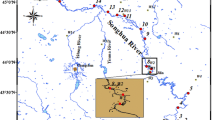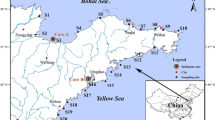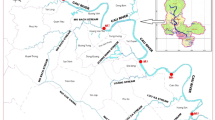Abstract
In this study, the distribution and partitioning of nine perfluorinated compounds (PFCs) in the water and sediment of Nansi Lake were systematically investigated. The total concentration of PFCs was in the range of 38.4–91.4 ng/L in the water and 0.47–1.81 ng/g in the sediment. The concentration of perfluorooctanoic acid (PFOA) was the highest in all the homologues in the water and was in the range of 34.9–84.6 ng/L. However, perfluorooctane sulfonate (PFOS), PFOA, and perfluoroundecanoic acid (PFUnDA) were the predominant PFCs in the sediment, and their levels were similar. The levels of PFOA, PFHpA, PFOS, PFNA, and the total PFCs in the water were relatively higher in the upper region than those in the lower region of Nansi Lake. In the sediment, the levels of PFOA, PFOS, and PFUnDA showed the similar distribution tendency. Industrial wastewater discharged from the cities around Nansi Lake was the main sources of PFCs. The partitioning coefficients (K d ) of PFOA, PFNA, PFDA, and PFOS were in the range of 0.29–0.87, 1.43–2.18, 2.08–3.15, and 2.20–2.80, respectively. Therefore, the log K d of PFDA and PFOS was apparently high as compared to two other compounds. The organic matter content of the sediment had no effect on the partitioning of PFCs between sediment and water in Nansi Lake.


Similar content being viewed by others
References
Ahrens, L., Taniyasu, S., Yeung, L. W., Yamashita, N., Lam, P. K., & Ebinghaus, R. (2010). Distribution of polyfluoroalkyl compounds in water, suspended particulate matter and sediment from Tokyo Bay, Japan. Chemosphere, 79(3), 266–272.
Ahrens, L., Yeung, L. W., Taniyasu, S., Lam, P. K., & Yamashita, N. (2011). Partitioning of perfluorooctanoate (PFOA), perfluorooctane sulfonate (PFOS) and perfluorooctane sulfonamide (PFOSA) between water and sediment. Chemosphere, 85(5), 731–737.
Bao, S. D., & Jiang, R. F. (1999). Analysis of Agri-Chemistry in Soil (pp. 34–35). Beijing: Chinese agricultural science and technology press (In Chinese with English abstract).
Becker, A. M., Gerstmann, S., & Frank, H. (2008). Perfluorooctanoic acid and perfluorooctane sulfonate in the sediment of the Roter Main river, Bayreuth, Germany. Environmental Pollution, 156(3), 818–820.
Bossi, R., Riget, F. F., & Dietz, R. (2005). Temporal and spatial trends of perfluorinated compounds in ringed seal (Phoca hispida) from Greenland. Environmental Science & Technology, 39(19), 7416–7422.
Cao, X., Shao, Y., Deng, W., Wang, H., & Wang, S. (2014). Spatial distribution and potential ecologic risk assessment of heavy metals in the sediments of the Nansi Lake in China. Environmental Monitoring and Assessment, 186(12), 8845–8856.
Chen, C., Wang, T., Khim, J. S., Luo, W., Jiao, W., Lu, Y., & Giesy, J. P. (2011). Perfluorinated compounds in water and sediment from coastal regions of the northern Bohai Sea, China. Chemistry and Ecology, 27(2), 165–176.
De Silva, A. O., Spencer, C., Scott, B. F., Backus, S., & Muir, D. C. (2011). Detection of a cyclic perfluorinated acid, perfluoroethylcyclohexane sulfonate, in the Great Lakes of North America. Environmental Science & Technology, 45(19), 8060–8066.
Dinglasan, M. J. A., Ye, Y., Edwards, E. A., & Mabury, S. A. (2004). Fluorotelomer alcohol biodegradation yields poly- and perfluorinated acids. Environmental Science & Technology, 38(10), 2857–2864.
Eriksen, K. T., Sørensen, M., McLaughlin, J. K., Tjønneland, A., Overvad, K., & Raaschou-Nielsen, O. (2010). Determinants of plasma PFOA and PFOS levels among 652 Danish men. Environmental Science & Technology, 45(19), 8137–8143.
Giesy, J. P., & Kannan, K. (2002). Peer reviewed: perfluorochemical surfactants in the environment. Environmental Science & Technology, 36(7), 146A–152A.
Higgins, C. P., & Luthy, R. G. (2006). Sorption of perfluorinated surfactants on sediments. Environmental Science & Technology, 40(23), 7251–7256.
Holmström, K. E., Järnberg, U., & Bignert, A. (2005). Temporal trends of PFOS and PFOA in guillemot eggs from the Baltic Sea, 1968–2003. Environmental Science & Technology, 39(1), 80–84.
Houde, M., Czub, G., Small, J. M., Backus, S., Wang, X., Alaee, M., & Muir, D. C. (2008). Fractionation and bioaccumulation of perfluorooctane sulfonate (PFOS) isomers in a Lake Ontario food web. Environmental Science & Technology, 42(24), 9397–9403.
Kissa, E. (Ed.). (2001). Fluorinated surfactants and repellents. CRC Press
Li, M. H. (2009). Toxicity of perfluorooctane sulfonate and perfluorooctanoic acid to plants and aquatic invertebrates. Environmental Toxicology, 24(1), 95–101.
Li, F., Sun, H., Hao, Z., He, N., Zhao, L., Zhang, T., & Sun, T. (2011). Perfluorinated compounds in Haihe River and Dagu drainage canal in Tianjin, China. Chemosphere, 84(2), 265–271.
Lindstrom, A. B., Strynar, M. J., & Libelo, E. L. (2011). Polyfluorinated compounds: past, present, and future. Environmental Science & Technology, 45(19), 7954–7961.
Olsen, G. W., Huang, H. Y., Helzlsouer, K. J., Hansen, K. J., Butenhoff, J. L., & Mandel, J. H. (2005). Historical comparison of perfluorooctanesulfonate, perfluorooctanoate, and other fluorochemicals in human blood. Environmental Health Perspectives, 539–545.
Orata, F., Quinete, N., Werres, F., & Wilken, R. D. (2009). Determination of perfluorooctanoic acid and perfluorooctane sulfonate in Lake Victoria Gulf water. Bulletin of Environmental Contamination and Toxicology, 82(2), 218–222.
Pan, G., & You, C. (2010). Sediment-water distribution of perfluorooctane sulfonate (PFOS) in Yangtze River Estuary. Environmental Pollution, 158(5), 1363–1367.
Pan, G., Zhou, Q., Luan, X., & Fu, Q. S. (2014). Distribution of perfluorinated compounds in Lake Taihu (China): impact to human health and water standards. Science of the Total Environment, 487, 778–784.
Prevedouros, K., Cousins, I. T., Buck, R. C., & Korzeniowski, S. H. (2006). Sources, fate and transport of perfluorocarboxylates. Environmental Science & Technology, 40(1), 32–44.
Shi, Y., Pan, Y., Wang, J., & Cai, Y. (2012). Distribution of perfluorinated compounds in water, sediment, biota and floating plants in Baiyangdian Lake, China. Journal of Environmental Monitoring, 14(2), 636–642.
Smithwick, M., Norstrom, R. J., Mabury, S. A., Solomon, K., Evans, T. J., Stirling, I., & Muir, D. C. (2006). Temporal trends of perfluoroalkyl contaminants in polar bears (Ursus maritimus) from two locations in the North American Arctic, 1972–2002. Environmental Science & Technology, 40(4), 1139–1143.
Wang, T., Chen, C., Naile, J. E., Khim, J. S., Giesy, J. P., & Lu, Y. (2011). Perfluorinated compounds in water, sediment and soil from Guanting Reservoir, China. Bulletin of Environmental Contamination and Toxicology, 87(1), 74–79.
Wang, S., Wang, H., & Deng, W. (2013). Perfluorooctane sulfonate (PFOS) distribution and effect factors in the water and sediment of the Yellow River Estuary, China. Environmental Monitoring and Assessment, 185(10), 8517–8524.
Wang, T., Wang, P., Meng, J., Liu, S., Lu, Y., Khim, J. S., & Giesy, J. P. (2015). A review of sources, multimedia distribution and health risks of perfluoroalkyl acids (PFAAs) in China. Chemosphere, 129, 87–99.
Wu, Z., Zhang, X., & Zhang, F. (2011). Filtration of heavily-polluted inflow rivers of Nansi Lake and water environmental problems analysis. Resources and Environment in the Yangtze Basin, 20, 475–481 (In Chinese with English abstract).
Xiao, F., Halbach, T. R., Simcik, M. F., & Gulliver, J. S. (2012). Input characterization of perfluoroalkyl substances in wastewater treatment plants: source discrimination by exploratory data analysis. Water research, 46(9), 3101–3109.
Yang, S., Xu, F., Wu, F., Wang, S., & Zheng, B. (2014). Development of PFOS and PFOA criteria for the protection of freshwater aquatic life in China. Science of The Total Environment, 470, 677–683.
You, C., Jia, C., & Pan, G. (2010). Effect of salinity and sediment characteristics on the sorption and desorption of perfluorooctane sulfonate at sediment-water interface. Environmental Pollution, 158(5), 1343–1347.
Zhang, Z., Sun, Q., Peng, L., Niu, Z., & Wu, A. (1999). Water environment problems in the Nansi Lake area. Journal of Lake Science, 11, 86–90 (In Chinese with English abstact).
Zhang, Y., Meng, W., Guo, C., Xu, J., Yu, T., Fan, W., & Li, L. (2012a). Determination and partitioning behavior of perfluoroalkyl carboxylic acids and perfluorooctanesulfonate in water and sediment from Dianchi Lake, China. Chemosphere, 88(11), 1292–1299.
Zhang, D., Zhang, L., Wei, Y., Wang, D., Luo, L., & Chen, Y. (2012b). Investigation of perfluorooctanoic acid (PFOA) and perfluorooctane sulfonate (PFOS) pollution in surface water of Poyang Lake. Resources and Environment in the Yangtze Basin, 21, 885–890 (In Chinese with English abstract).
Zhang, G., Pan, Z., Bai, A., Li, J., & Li, X. (2014). Distribution and bioaccumulation of organochlorine pesticides (OCPs) in food web of Nansi Lake, China. Environmental Monitoring and Assessment, 186(4), 2039–2051.
Zhou, Z., Liang, Y., Shi, Y., Xu, L., & Cai, Y. (2013). Occurrence and transport of perfluoroalkyl acids (PFAAs), including short-chain PFAAs in Tangxun Lake, China. Environmental Science & Technology, 47(16), 9249–9257.
Acknowledgments
This study is supported by the Encouraging Foundation for Outstanding Youth Scientists of Shandong Province (No. BS2012HZ006), the Key Program of the National Natural Science Foundation of China (No.51138006), the National Key Research Project on Water Environmental Pollution Control in China (No.2012ZX07313-001), and the First Class General Financial Grant from the China Postdoctoral Science Foundation (No.2013 M540103).
Compliance with Ethical Standards
All procedures performed in studies involving human participants were in accordance with the ethical standards of the institutional and/or national research committee and with the 1964 Helsinki declaration and its later amendments or comparable ethical standards. This article does not contain any studies with animals performed by any of the authors. Informed consent was obtained from all individual participants included in the study.
Conflict of interest
The authors declare that they have no competing interests.
Author information
Authors and Affiliations
Corresponding author
Rights and permissions
About this article
Cite this article
Cao, Y., Cao, X., Wang, H. et al. Assessment on the distribution and partitioning of perfluorinated compounds in the water and sediment of Nansi Lake, China. Environ Monit Assess 187, 611 (2015). https://doi.org/10.1007/s10661-015-4831-9
Received:
Accepted:
Published:
DOI: https://doi.org/10.1007/s10661-015-4831-9




